back up Acura MDX 2015 Owner's Guide
[x] Cancel search | Manufacturer: ACURA, Model Year: 2015, Model line: MDX, Model: Acura MDX 2015Pages: 79, PDF Size: 16.44 MB
Page 6 of 79
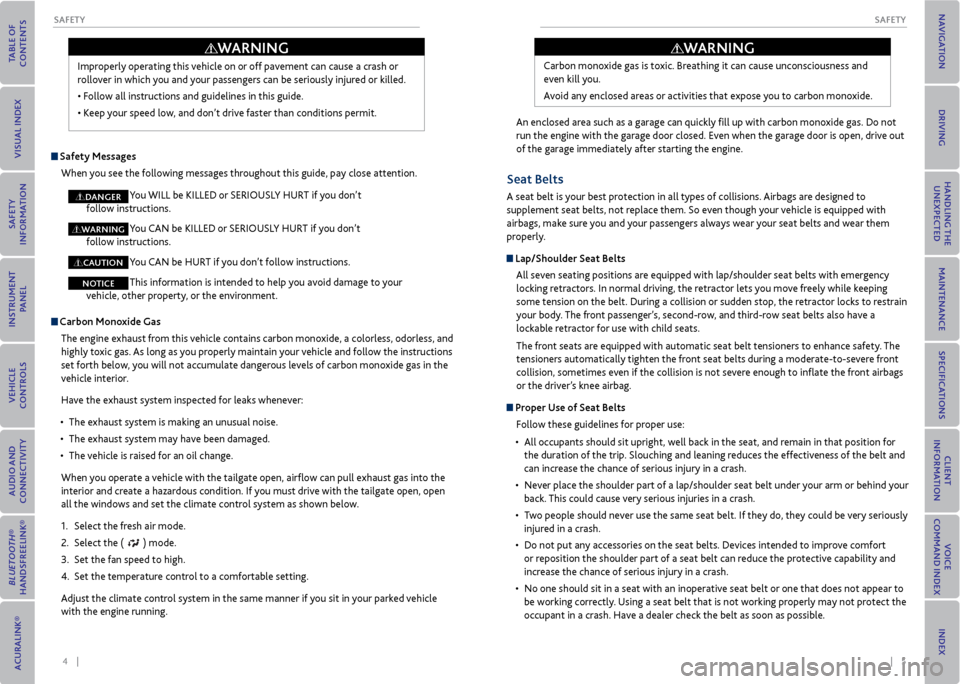
4 || 5
SAFeTy
SAFeTy
Carbon monoxide Gas
The engine exhaust from this vehicle contains carbon monoxide, a colorless, odorless, and
highly toxic gas. As long as you properly maintain your vehicle and follow the instructions
set forth below, you will not accumulate dangerous levels of carbon monoxide gas in the
vehicle interior.
Have the exhaust system inspected for leaks whenever:
• The exhaust system is making an unusual noise.
• The exhaust system may have been damaged.
• The vehicle is raised for an oil change.
When you operate a vehicle with the tailgate open, airflow can pull exhaust gas into the
interior and create a hazardous condition. If you must drive with the tailgate open, open
all the windows and set the climate control system as shown below.
1. Select the fresh air mode.
2. Select the (
) mode.
3. Set the fan speed to high.
4. Set the temperature control to a comfortable setting.
Adjust the climate control system in the same manner if you sit in your parked vehicle
with the engine running. Improperly operating this vehicle on or off pavement can cause a crash or
rollover in which you and your passengers can be seriously injured or killed.
• Follow all instructions and guidelines in
this guide.
• Keep your speed low, and don’t drive faster than conditions permit.
WArNING
Safety messages
When you see the following messages throughout this guide, pay close attention.
You WILL be KILLED or SERIOUSLY HURT if you don’t
follow instructions.
You CAN be KILLED or SERIOUSLY HURT if you don’t
follow instructions.
You CAN be HURT if you don’t follow instructions.
This information is intended to help you avoid damage to your
vehicle, other property, or the environment.
WArNING
CAUTIoN
NoTICe
DANGer
An enclosed area such as a garage can quickly fill up with carbon monoxide gas. Do not
run the engine with the garage door closed. Even when the garage door is open, drive out
of the garage immediately after starting the engine. Carbon monoxide gas is toxic. Breathing it can cause unconsciousness and
even kill you.
Avoid any enclosed areas or activities that expose you to carbon monoxide.
WArNING
Seat Belts
A seat belt is your best protection in all types of collisions. Airbags are designed to
supplement seat belts, not replace them. So even though your vehicle is equipped with
airbags, make sure you and your passengers always wear your seat belts and wear them
properly.
Lap/Shoulder Seat Belts
All seven seating positions are equipped with lap/shoulder seat belts with emergency
locking retractors. In normal driving, the retractor lets you move freely while keeping
some tension on the belt. During a collision or sudden stop, the retractor locks to restrain
your body. The front passenger’s, second-row, and third-row seat belts also have a
lockable retractor for use with child seats.
The front seats are equipped with automatic seat belt tensioners to enhance safety. The
tensioners automatically tighten the front seat belts during a moderate-to-severe front
collision, sometimes even if the collision is not severe enough to inflate the front airbags
or the driver’s knee airbag.
Proper Use of Seat BeltsFollow these guidelines for proper use:
• All occupants should sit upright, well back in the seat, and remain in that position for
the duration of the trip. Slouching and leaning reduces the effectiveness of the belt and
can increase the chance of serious injury in a crash.
• Never place the shoulder part of a lap/shoulder seat belt under your arm or behind your
back. This could cause very serious injuries in a crash.
• Two people should never use the same seat belt. If they do, they could be very seriously
injured in a crash.
• Do not put any accessories on the seat belts. Devices intended to improve comfort
or reposition the shoulder part of a seat belt can reduce the protective capability and
increase the chance of serious injury in a crash.
• No one should sit in a seat with an inoperative seat belt or one that does not appear to
be working correctly. Using a seat belt that is not working properly may not protect the
occupant in a crash. Have a dealer check the belt as soon as possible.
Page 9 of 79
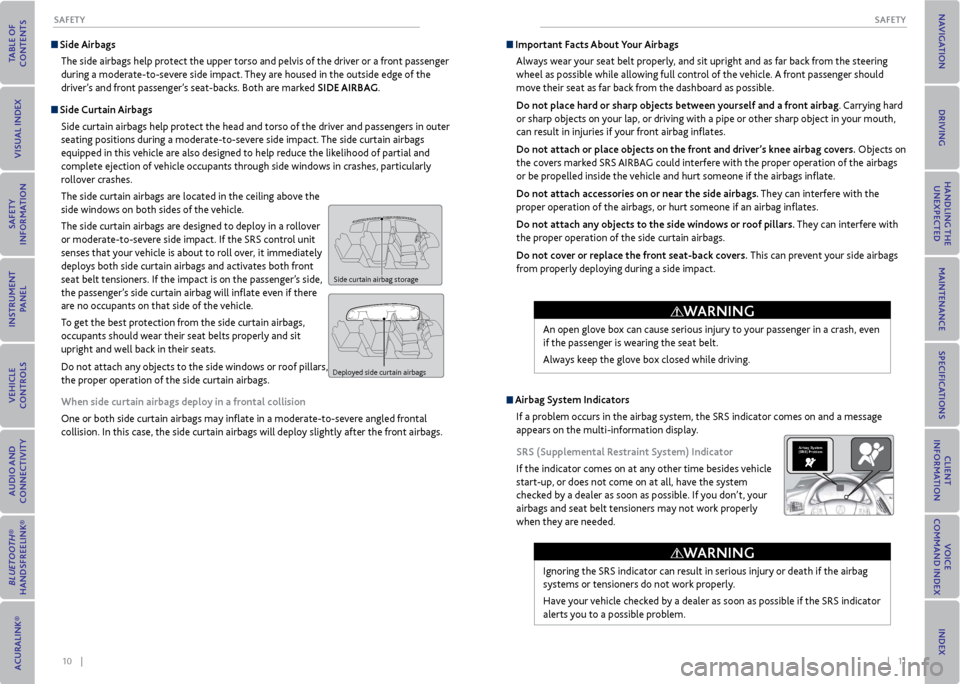
10 || 11
SAFeTy
SAFeTy
Side Airbags
The side airbags help protect the upper torso and pelvis of the driver or a front passenger
during a moderate-to-severe side impact. They are housed in the outside edge of the
driver’s and front passenger’s seat-backs. Both are marked SIDe AIrBAG.
Side Curtain Airbags
Side curtain airbags help protect the head and torso of the driver and passengers in outer
seating positions during a moderate-to-severe side impact. The side curtain airbags
equipped in this vehicle are also designed to help reduce the likelihood of partial and
complete ejection of vehicle occupants through side windows in crashes, particularly
rollover crashes.
The side curtain airbags are located in the ceiling above the
side windows on both sides of the vehicle.
The side curtain airbags are designed to deploy in a rollover
or moderate-to-severe side impact. If the SRS control unit
senses that your vehicle is about to roll over, it immediately
deploys both side curtain airbags and activates both front
seat belt tensioners. If the impact is on the passenger’s side,
the passenger’s side curtain airbag will inflate even if there
are no occupants on that side of the vehicle.
To get the best protection from the side curtain airbags,
occupants should wear their seat belts properly and sit
upright and well back in their seats.
Do not attach any objects to the side windows or roof pillars, as they can interfere with
the proper operation of the side curtain airbags.
When side curtain airbags deploy in a frontal collision
One or both side curtain airbags may inflate in a moderate-to-severe angled frontal
collision. In this case, the side curtain airbags will deploy slightly after the front airbags.
Side curtain airbag storage
Deployed side curtain airbags
Important Facts About your Airbags
Always wear your seat belt properly, and sit upright and as far back from the steering
wheel as possible while allowing full control of the vehicle. A front passenger should
move their seat as far back from the dashboard as possible.
Do not place hard or sharp objects between yourself and a front airbag. Carrying hard
or sharp objects on your lap, or driving with a pipe or other sharp object in your mouth,
can result in injuries if your front airbag inflates.
Do not attach or place objects on the front and driver’s knee airbag covers. Objects on
the covers marked SRS AIRBAG could interfere with the proper operation of the airbags
or be propelled inside the vehicle and hurt someone if the airbags inflate.
Do not attach accessories on or near the side airbags. They can interfere with the
proper operation of the airbags, or hurt someone if an airbag inflates.
Do not attach any objects to the side windows or roof pillars. They can interfere with
the proper operation of the side curtain airbags.
Do not cover or replace the front seat-back covers. This can prevent your side airbags
from properly deploying during a side impact.
Ignoring the SRS indicator can result in serious injury or death if the airbag
systems or tensioners do not work properly.
Have your vehicle checked by a dealer as soon as possible if the SRS indicator
alerts you to a possible problem.
Airbag System
(SRS) Problem
WArNING
Airbag System Indicators
If a problem occurs in the airbag system, the SRS indicator comes on and a message
appears on the multi-information display.
SrS (Supplemental r estraint System) Indicator
If the indicator comes on at any other time besides vehicle
start-up, or does not come on at all, have the system
checked by a dealer as soon as possible. If you don’t, your
airbags and seat belt tensioners may not work properly
when they are needed. An open glove box can cause serious injury to your passenger in a crash, even
if the passenger is wearing the seat belt.
Always keep the glove box closed while driving.
WArNING
Page 10 of 79
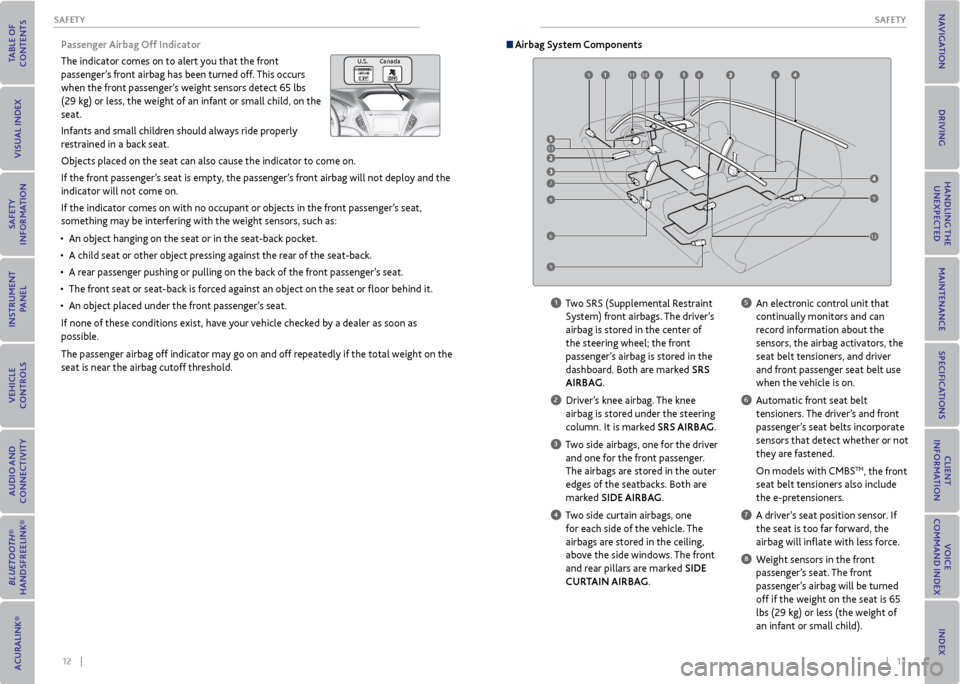
12 || 13
SAFeTy
SAFeTy
Passenger Airbag off Indicator
The indicator comes on to alert you that the front
passenger’s front airbag has been turned off. This occurs
when the front passenger’s weight sensors detect 65 lbs
(29 kg) or less, the weight of an infant or small child, on the
seat.
Infants and small children should always ride properly
restrained in a back seat.
Objects placed on the seat can also cause the indicator to come on.
If the front passenger’s seat is empty, the passenger’s front airbag will not deploy and the
indicator will not come on.
If the indicator comes on with no occupant or objects in the front passenger’s seat,
something may be interfering with the weight sensors, such as:
• An object hanging on the seat or in the seat-back pocket.
• A child seat or other object pressing against the rear of the seat-back.
• A rear passenger pushing or pulling on the back of the front passenger’s seat.
• The front seat or seat-back is forced against an object on the seat or floor behind it.
• An object placed under the front passenger’s seat.
If none of these conditions exist, have your vehicle checked by a dealer as soon as
possible.
The passenger airbag off indicator may go on and off repeatedly if the total weight on the
seat is near the airbag cutoff threshold.
U.S. Canada
Airbag System Components
13
6
7
810119
99
9
612
9
1 Two SRS (Supplemental Restraint
System) front airbags. The driver’s
airbag is stored in the center of
the steering wheel; the front
passenger’s airbag is stored in the
dashboard. Both are marked SrS
AIrBAG.
2 Driver’s knee airbag. The knee airbag is stored under the steering
column. It is marked SrS AIrBAG.
3 Two side airbags, one for the driver and one for the front passenger.
The airbags are stored in the outer
edges of the seatbacks. Both are
marked SIDe AIrBAG.
4 Two side curtain airbags, one for each side of the vehicle. The
airbags are stored in the ceiling,
above the side windows. The front
and rear pillars are marked SIDe
CUr TAIN AIrBAG.
5 An electronic control unit that
continually monitors and can
record information about the
sensors, the airbag activators, the
seat belt tensioners, and driver
and front passenger seat belt use
when the vehicle is on.
6 Automatic front seat belt tensioners. The driver’s and front
passenger’s seat belts incorporate
sensors that detect whether or not
they are fastened.
On models with CMBS
TM, the front
seat belt tensioners also include
the e-pretensioners.
7 A driver’s seat position sensor. If the seat is too far forward, the
airbag will inflate with less force.
8 Weight sensors in the front passenger’s seat. The front
passenger’s airbag will be turned
off if the weight on the seat is 65
lbs (29 kg) or less (the weight of
an infant or small child).
Page 12 of 79
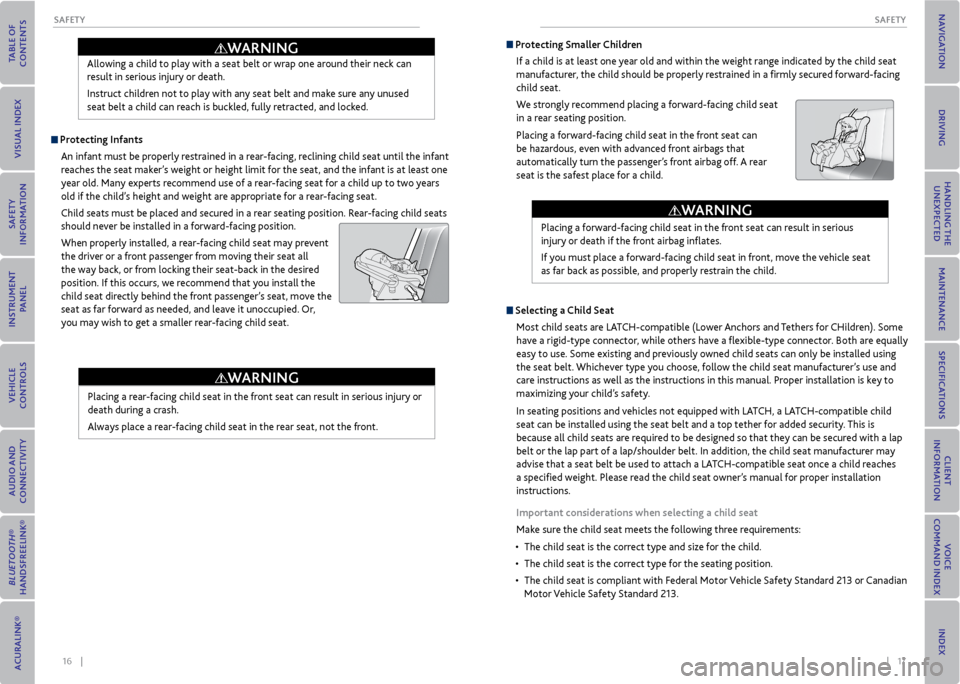
16 || 17
SAFeTy
SAFeTy
Protecting Infants
An infant must be properly restrained in a rear-facing, reclining child seat until the infant
reaches the seat maker’s weight or height limit for the seat, and the infant is at least one
year old. Many experts recommend use of a rear-facing seat for a child up to two years
old if the child’s height and weight are appropriate for a rear-facing seat.
Child seats must be placed and secured in a rear seating position. Rear-facing child seats
should never be installed in a forward-facing position.
When properly installed, a rear-facing child seat may prevent
the driver or a front passenger from moving their seat all
the way back, or from locking their seat-back in the desired
position. If this occurs, we recommend that you install the
child seat directly behind the front passenger’s seat, move the
seat as far forward as needed, and leave it unoccupied. Or,
you may wish to get a smaller rear-facing child seat. Allowing a child to play with a seat belt or wrap one around their neck can
result in serious injury or death.
Instruct children not to play with any seat belt and make sure any unused
seat belt a child can reach is buckled, fully retracted, and locked.
Placing a rear-facing child seat in the front seat can result in serious injury or
death during a crash.
Always place a rear-facing child seat in the rear seat, not the front.
WArNING
WArNING
Protecting Smaller Children
If a child is at least one year old and within the weight range indicated by the child seat
manufacturer, the child should be properly restrained in a firmly secured forward-facing
child seat.
We strongly recommend placing a forward-facing child seat
in a rear seating position.
Placing a forward-facing child seat in the front seat can
be hazardous, even with advanced front airbags that
automatically turn the passenger’s front airbag off. A rear
seat is the safest place for a child.
Placing a forward-facing child seat in the front seat can result in serious
injury or death if the front airbag inflates.
If you must place a forward-facing child seat in front, move the vehicle seat
as far back as possible, and properly restrain the child.
Selecting a Child Seat
Most child seats are LATCH-compatible (Lower Anchors and Tethers for CHildren). Some
have a rigid-type connector, while others have a flexible-type connector. Both are equally
easy to use. Some existing and previously owned child seats can only be installed using
the seat belt. Whichever type you choose, follow the child seat manufacturer’s use and
care instructions as well as the instructions in this manual. Proper installation is key to
maximizing your child’s safety.
In seating positions and vehicles not equipped with LATCH, a LATCH-compatible child
seat can be installed using the seat belt and a top tether for added security. This is
because all child seats are required to be designed so that they can be secured with a lap
belt or the lap part of a lap/shoulder belt. In addition, the child seat manufacturer may
advise that a seat belt be used to attach a LATCH-compatible seat once a child reaches
a specified weight. Please read the child seat owner’s manual for proper installation
instructions.
Important considerations when selecting a child seat
Make sure the child seat meets the following three requirements:
• The child seat is the correct type and size for the child.
• The child seat is the correct type for the seating position.
• The child seat is compliant with Federal Motor Vehicle Safety Standard 213 or Canadian
Motor Vehicle Safety Standard 213.
WArNING
Page 13 of 79
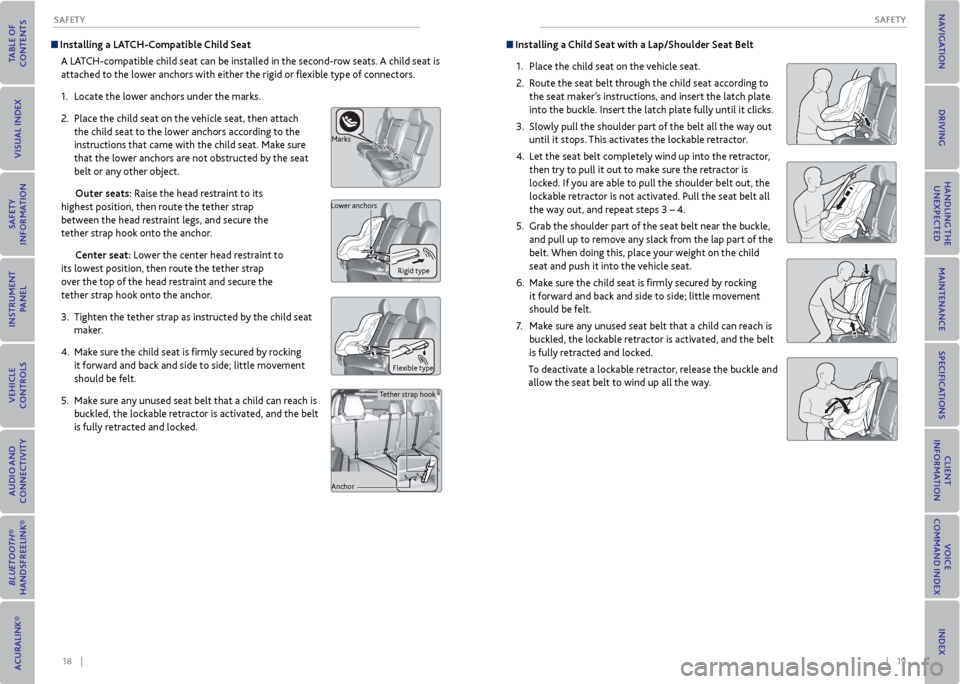
18 || 19
SAFeTy
SAFeTy
Installing a LATCH-Compatible Child Seat
A LATCH-compatible child seat can be installed in the second-row seats. A child seat is
attached to the lower anchors with either the rigid or flexible type of connectors.
1. Locate the lower anchors under the marks.
2. Place the child seat on the vehicle seat, then attach
the child seat to the lower anchors according to the
instructions that came with the child seat. Make sure
that the lower anchors are not obstructed by the seat
belt or any other object.
outer seats: Raise the head restraint to its
highest position, then route the tether strap
between the head restraint legs, and secure the
tether strap hook onto the anchor.
Center seat: Lower the center head restraint to
its lowest position, then route the tether strap
over the top of the head restraint and secure the
tether strap hook onto the anchor.
3. Tighten the tether strap as instructed by the child seat
maker.
4. Make sure the child seat is firmly secured by rocking
it forward and back and side to side; little movement
should be felt.
5. Make sure any unused seat belt that a child can reach is
buckled, the lockable retractor is activated, and the belt
is fully retracted and locked.
Marks
Lower anchors Rigid type
Flexible type
Tether strap hook
Anchor
Installing a Child Seat with a Lap/Shoulder Seat Belt 1. Place the child seat on the vehicle seat.
2. Route the seat belt through the child seat according to
the seat maker’s instructions, and insert the latch plate
into the buckle. Insert the latch plate fully until it clicks.
3. Slowly pull the shoulder part of the belt all the way out
until it stops. This activates the lockable retractor.
4. Let the seat belt completely wind up into the retractor,
then try to pull it out to make sure the retractor is
locked. If you are able to pull the shoulder belt out, the
lockable retractor is not activated. Pull the seat belt all
the way out, and repeat steps 3 – 4.
5. Grab the shoulder part of the seat belt near the buckle,
and pull up to remove any slack from the lap part of the
belt. When doing this, place your weight on the child
seat and push it into the vehicle seat.
6. Make sure the child seat is firmly secured by rocking
it forward and back and side to side; little movement
should be felt.
7. Make sure any unused seat belt that a child can reach is
buckled, the lockable retractor is activated, and the belt
is fully retracted and locked.
To deactivate a lockable retractor, release the buckle and
allow the seat belt to wind up all the way.
Page 14 of 79
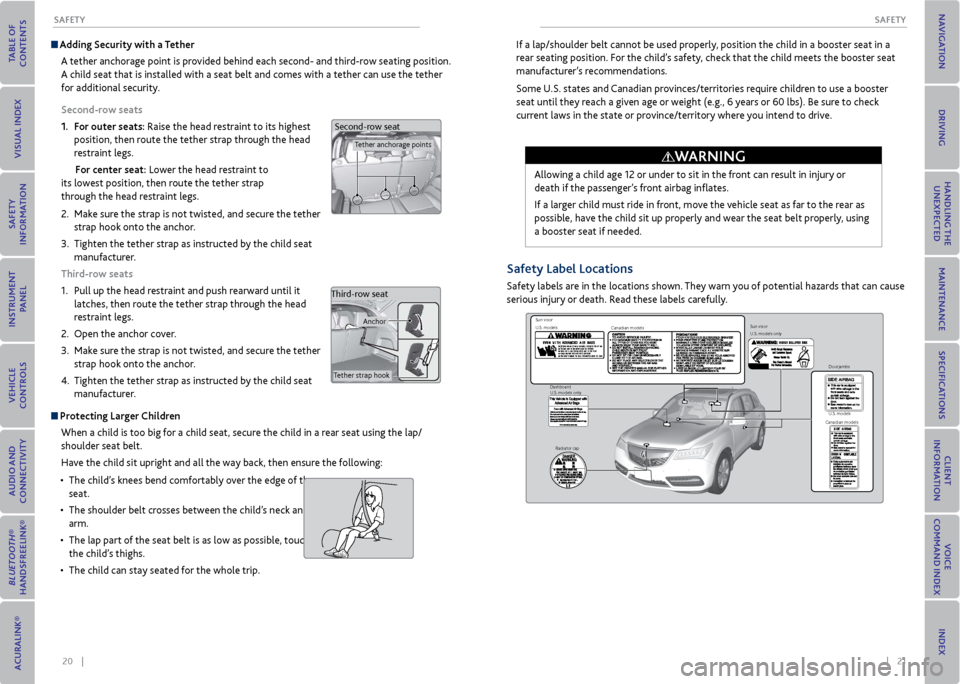
20 || 21
SAFeTy
SAFeTy
Adding Security with a Tether
A tether anchorage point is provided behind each second- and third-row seating position.
A child seat that is installed with a seat belt and comes with a tether can use the tether
for additional security.
Second-row seats
1. For outer seats: Raise the head restraint to its highest
position, then route the tether strap through the head
restraint legs.
For center seat: Lower the head restraint to
its lowest position, then route the tether strap
through the head restraint legs.
2. Make sure the strap is not twisted, and secure the tether
strap hook onto the anchor.
3. Tighten the tether strap as instructed by the child seat
manufacturer.
Third-row seats
1. Pull up the head restraint and push rearward until it
latches, then route the tether strap through the head
restraint legs.
2. Open the anchor cover.
3. Make sure the strap is not twisted, and secure the tether
strap hook onto the anchor.
4. Tighten the tether strap as instructed by the child seat
manufacturer.
Protecting Larger Children
When a child is too big for a child seat, secure the child in a rear seat using the lap/
shoulder seat belt.
Have the child sit upright and all the way back, then ensure the following:
• The child’s knees bend comfortably over the edge of the
seat.
• The shoulder belt crosses between the child’s neck and
arm.
• The lap part of the seat belt is as low as possible, touching
the child’s thighs.
• The child can stay seated for the whole trip.
Tether anchorage points
Allowing a child age 12 or under to sit in the front can result in injury or
death if the passenger’s front airbag inflates.
If a larger child must ride in front, move the vehicle seat as far to the rear as
possible, have the child sit up properly and wear the seat belt properly, using
a booster seat if needed.
Safety Label Locations
Safety labels are in the locations shown. They warn you of potential hazards that can cause
serious injury or death. Read these labels carefully.
Sun viso r
U.S. mode ls
Canadian models
Radiator cap U.
S. models
U.S. models only
Dashboard
Canadian modelsDoorjamb
s
U.S. models only
Sun viso
r
If a lap/shoulder belt cannot be used properly, position the child in a booster seat in a
rear seating position. For the child’s safety, check that the child meets the booster seat
manufacturer’s recommendations.
Some U.S. states and Canadian provinces/territories require children to use a booster
seat until they reach a given age or weight (e.g., 6 years or 60 lbs). Be sure to check
current laws in the state or province/territory where you intend to drive.
WArNING
Second-row seat
Anchor
Tether strap hook
Third-row seat
Page 18 of 79
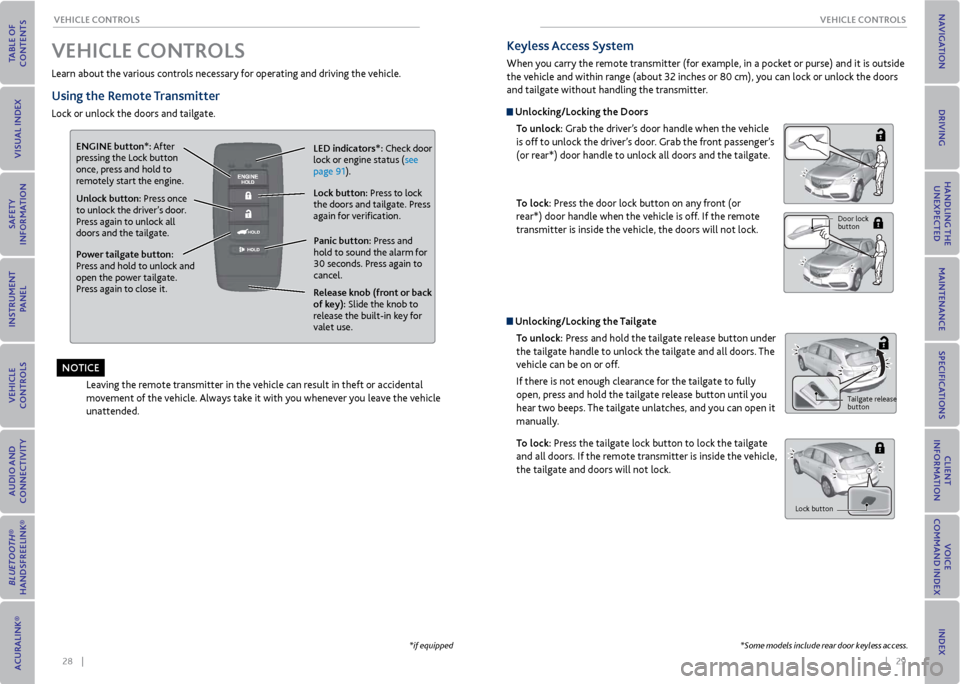
28 || 29
veHICLe CoNTroLS
veHICLe CoNTroLS
Learn about the various controls necessary for operating and driving the vehicle.
Using the remote Transmitter
Lock or unlock the doors and tailgate.
Unlock button: Press once
to unlock the driver’s door.
Press again to unlock all
doors and the tailgate.
release knob (front or back
of key): Slide the knob to
release the built-in key for
valet use.
Power tailgate button:
Press and hold to unlock and
open the power tailgate.
Press again to close it. Lock button: Press to lock
the doors and tailgate. Press
again for verification. LeD indicators*: Check door
lock or engine status (see
page 91).
Panic button: Press and
hold to sound the alarm for
30 seconds. Press again to
cancel.
veHICLe CoNTroLS
Leaving the remote transmitter in the vehicle can result in theft or accidental
movement of the vehicle. Always take it with you whenever you leave the vehicle
unattended.
eNGINe button*: After
pressing the Lock button
once, press and hold to
remotely start the engine.
*if equipped
Unlocking/Locking the Tailgate
To unlock: Press and hold the tailgate release button under
the tailgate handle to unlock the tailgate and all doors. The
vehicle can be on or off.
If there is not enough clearance for the tailgate to fully
open, press and hold the tailgate release button until you
hear two beeps. The tailgate unlatches, and you can open it
manually.
To lock: Press the tailgate lock button to lock the tailgate
and all doors. If the remote transmitter is inside the vehicle,
the tailgate and doors will not lock.
Tailgate release
button
Lock button
Keyless Access System
When you carry the remote transmitter (for example, in a pocket or purse) and it is outside
the vehicle and within range (about 32 inches or 80 cm), you can lock or unlock the doors
and tailgate without handling the transmitter.
Unlocking/Locking the Doors
To unlock: Grab the driver’s door handle when the vehicle
is off to unlock the driver’s door. Grab the front passenger’s
(or rear*) door handle to unlock all doors and the tailgate.
To lock: Press the door lock button on any front (or
rear*) door handle when the vehicle is off. If the remote
transmitter is inside the vehicle, the doors will not lock.
Door lock
button
*Some models include rear door keyless access.
NoTICe
Page 20 of 79
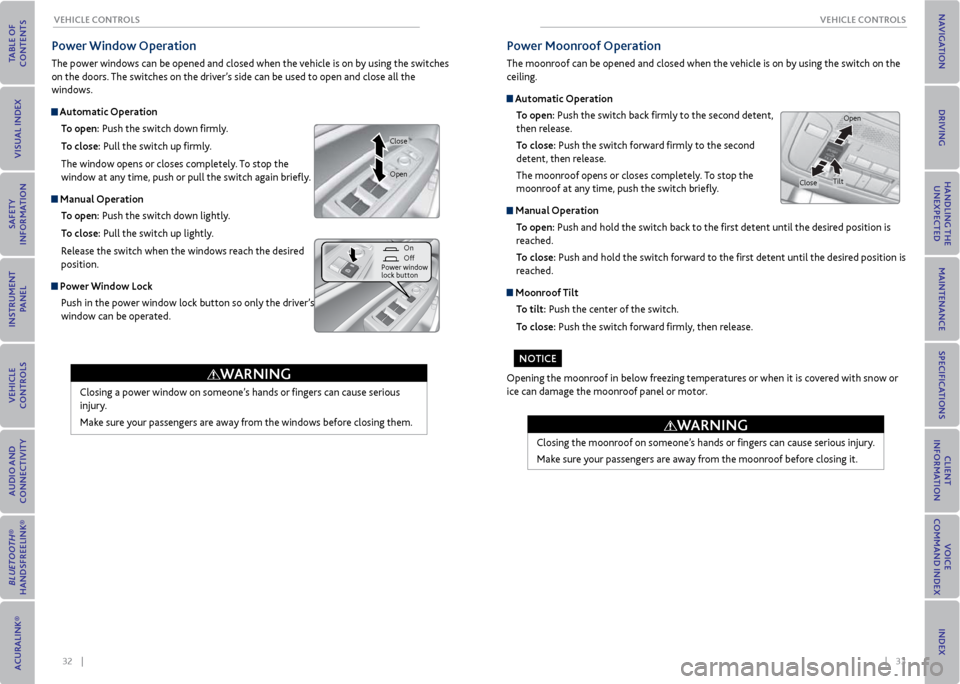
32 || 33
veHICLe CoNTroLS
veHICLe CoNTroLS
Power Window operation
The power windows can be opened and closed when the vehicle is on by using the switches
on the doors. The switches on the driver’s side can be used to open and close all the
windows.
Automatic operation
To open: Push the switch down firmly.
To close: Pull the switch up firmly.
The window opens or closes completely. To stop the
window at any time, push or pull the switch again briefly.
manual operation
To open: Push the switch down lightly.
To close: Pull the switch up lightly.
Release the switch when the windows reach the desired
position.
Power Window Lock Push in the power window lock button so only the driver’s
window can be operated.
Closing a power window on someone’s hands or fingers can cause serious
injury.
Make sure your passengers are away from the windows before closing them.
WArNING
Close
Power moonroof operation
The moonroof can be opened and closed when the vehicle is on by using the switch on the
ceiling.
Automatic operation
To open: Push the switch back firmly to the second detent,
then release.
To close: Push the switch forward firmly to the second
detent, then release.
The moonroof opens or closes completely. To stop the
moonroof at any time, push the switch briefly.
manual operation
To open: Push and hold the switch back to the first detent until the desired position is
reached.
To close: Push and hold the switch forward to the first detent until the desired position is
reached.
moonroof Tilt
To tilt: Push the center of the switch.
To close: Push the switch forward firmly, then release.
Closing the moonroof on someone’s hands or fingers can cause serious injury.
Make sure your passengers are away from the moonroof before closing it.
Opening the moonroof in below freezing temperatures or when it is covered with snow or
ice can damage the moonroof panel or motor.
Open
CloseTilt
WArNING
On
Off
Power window
lock button
Open
No TICe
Page 23 of 79
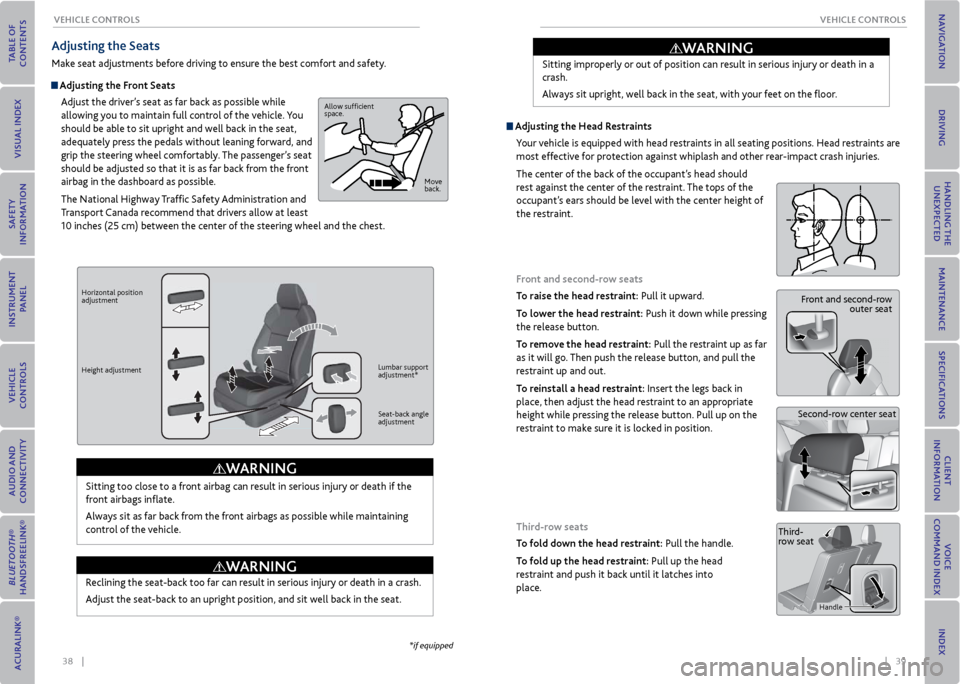
38 || 39
veHICLe CoNTroLS
veHICLe CoNTroLS
Adjusting the Seats
Make seat adjustments before driving to ensure the best comfort and safety.
Adjusting the Front Seats
Adjust the driver’s seat as far back as possible while
allowing you to maintain full control of the vehicle. You
should be able to sit upright and well back in the seat,
adequately press the pedals without leaning forward, and
grip the steering wheel comfortably. The passenger’s seat
should be adjusted so that it is as far back from the front
airbag in the dashboard as possible.
The National Highway Traffic Safety Administration and
Transport Canada recommend that drivers allow at least
10 inches (25 cm) between the center of the steering wheel and the chest.
Sitting too close to a front airbag can result in serious injury or death if the
front airbags inflate.
Always sit as far back from the front airbags as possible while maintaining
control of the vehicle.
Allow sufficient
space.
Move
back.
Horizontal position
adjustment
Height adjustment Lumbar support
adjustment*
Seat-back angle
adjustment
WArNING
*if equipped
Reclining the seat-back too far can result in serious injury or death in a crash.
Adjust the seat-back to an upright position, and sit well back in the seat.
Sitting improperly or out of position can result in serious injury or death in a
crash.
Always sit upright, well back in the seat, with your feet on the floor.
Adjusting the
Head restraints
Your vehicle is equipped with head restraints in all seating positions. Head restraints are
most effective for protection against whiplash and other rear-impact crash injuries.
The center of the back of the occupant’s head should
rest against the center of the restraint. The tops of the
occupant’s ears should be level with the center height of
the restraint.
Front and second-row seats
To raise the head restraint: Pull it upward.
To lower the head restraint: Push it down while pressing
the release button.
To remove the head restraint: Pull the restraint up as far
as it will go. Then push the release button, and pull the
restraint up and out.
To reinstall a head restraint: Insert the legs back in
place, then adjust the head restraint to an appropriate
height while pressing the release button. Pull up on the
restraint to make sure it is locked in position.
Front and second-row outer seat
Second-row center seat
WArNING
WArNING
Third-row seats
To fold down the head restraint: Pull the handle.
To fold up the head restraint: Pull up the head
restraint and push it back until it latches into
place.Third-
row seat
Handle
Page 24 of 79
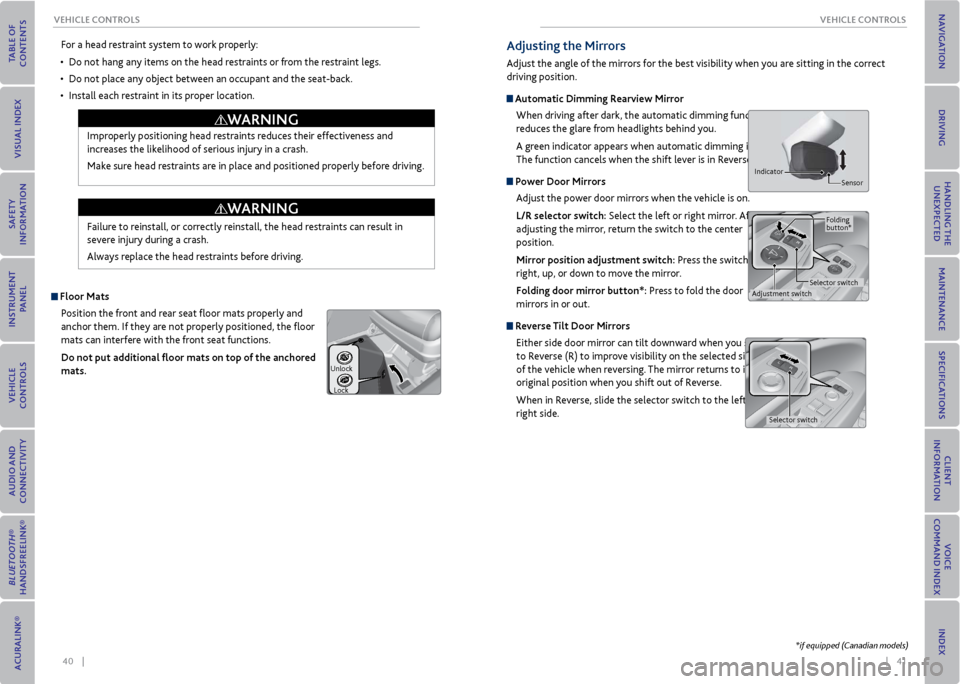
40 || 41
veHICLe CoNTroLS
veHICLe CoNTroLS
For a head restraint system to work properly:
• Do not hang any items on the head restraints or from the restraint legs.
• Do not place any object between an occupant and the seat-back.
• Install each restraint in its proper location.
Improperly positioning head restraints reduces their effectiveness and
increases the likelihood of serious injury in a crash.
Make sure head restraints are in place and positioned properly before driving.
Failure to reinstall, or correctly reinstall, the head restraints can result in
severe injury during a crash.
Always replace the head restraints before driving.
WArNING
WArNING
Floor matsPosition the front and rear seat floor mats properly and
anchor them. If they are not properly positioned, the floor
mats can interfere with the front seat functions.
Do not put additional floor mats on top of the anchored
mats.
Unlock
Lock
Adjusting the mirrors
Adjust the angle of the mirrors for the best visibility when you are sitting in the correct
driving position.
Automatic Dimming r earview mirror
When driving after dark, the automatic dimming function
reduces the glare from headlights behind you.
A green indicator appears when automatic dimming is on.
The function cancels when the shift lever is in Reverse (R).
Power Door mirrors Adjust the power door mirrors when the vehicle is on.
L/r selector switch: Select the left or right mirror. After
adjusting the mirror, return the switch to the center
position.
mirror position adjustment switch: Press the switch left,
right, up, or down to move the mirror.
Folding door mirror button*: Press to fold the door
mirrors in or out.
r everse Tilt Door mirrors
Either side door mirror can tilt downward when you shift
to Reverse (R) to improve visibility on the selected side
of the vehicle when reversing. The mirror returns to its
original position when you shift out of Reverse.
When in Reverse, slide the selector switch to the left or
right side.
Indicator Sensor
Adjustment switchSelector switchFolding
button*
Selector switch
*if equipped (Canadian models)